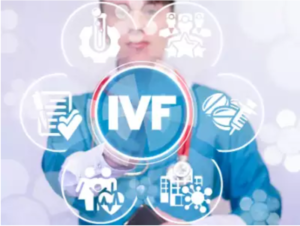In Vitro Fertilization, better known as IVF, can be an overwhelming. The process can take it all out of you, emotionally and physically, but in the end I can tell you it is all worth it. IVF is one of the techniques known as ART, Assisted Reproductive Technology. It has the highest per-cycle success rate of any ART treatments. I sincerely believe that if you understand the process from the beginning it can take so much of the stress and pressure out of it. That is something I focus to do with my clients. I have personally been through four full rounds of IVF, with my third round giving us our little girl.

The IVF Process
Stimulation
- You will start with various shots and medications to help stimulate your ovaries to an attempt to get as many eggs possible. Let’s walk through this process. I also suggest starting a supplement regimen alongside to improve egg quality. You can see my blog on this subject, as well. I suggest starting this regimen 3 months before you begin your IVF cycle.
- Around day 3 of your cycle you will go to the clinic for your baseline ultrasound. Here they check your uterine lining via ultrasound, as well as taking blood work to check hormone levels.
- Now the fun begins. You will begin taking various shots to stimulate your ovaries. This additional stimulation is to get your body to produce a larger number of eggs than it usually would. It is important that you do these injections at the same time each day (I suggest evening). This will go on for approximately 10 days, or until the doctor feels that your follicles measure well and are ready for retrieval.
- Your doctor/nurse will be tracking your uterine lining and follicle development throughout the process with ultrasound appointments and blood work. When your doctor feels like the follicles are ready you will do a shot known as the trigger shot. This is done a few days before the eggs have fully matured.
Retrieval
- Approximately 2 days after the trigger shot, you will have an egg retrieval. This is a minor, outpatient procedure. You are put under light anesthesia to ensure you are able to keep still and comfortable during the procedure. The mature eggs are removed from the ovaries using a tiny hollow needle, in a procedure that lasts no more than 15 minutes.
- The morning of the procedure the partner will provide fresh sperm at the doctor’s office. For men with lower sperm count or for donor sperm, sperm can be retrieved beforehand and frozen, then thawed for the retrieval.
- The embryologist then puts the eggs into an environment that mimics the Fallopian tubes.
- You may experience some cramping through the remainder of the day after your procedure. This should subside and you can return to normal activity the following day.
Fertilization
- After your eggs are retrieved, they can take up to 6 hours to reach their final stage of maturity. Once this occurs, they can be fertilized with the sperm. Embryologists have two options with it comes to fertilization:
- ICSI- Intracystoplasmic Sperm Injection. With this process the embryologists chooses what they believe to be the best sperm and inject a single sperm directly into each egg.
- Conventional- The sperm are combined with the eggs in a Petri dish and are stored in an incubator to allow them to naturally fertilize on their own (similar to what happens in the woman’s body).
- There are phases within the process that you may hear about. The initial count that is provided post-procedure is the number of eggs successfully retrieved. From there, a portion of them will mature over that 6 hour period. Those are the eggs that can move forward to fertilization. Many clinics will call you the next day and give you this number. Of those eggs, you have the total that were successfully fertilized. Of the fertilized embryos, you will have a portion that made it to blastocyst. I have low AMH, so I produce less eggs, but let me lay out my last retrieval. We had 11 eggs retrieved, 8 were fertilized, 2 made it to blastocyst. Keep in mind that my numbers are lower due to my age and hormone levels.
- Embryologist will give the embryos grades to let the doctor know the highest quality embryo, and therefore the best one to transfer. Keep in mind this grading is very subjective, so don’t get discouraged if you have different grades of embryos.
Implantation
- The final stage is the embryo transfer, or implantation as many call it, takes place after the embryos continued to grow in the laboratory for 3-7 days, or until they reach blastocyst are ready for transfer. For a fresh transfer, this is the point when embryo(s) are transferred into the patient’s uterus. Any additional embryos can be frozen at this time for future implantation.
- For fresh or frozen transfers, the patient is often times started on a regimen of estrogen and progesterone. Progesterone helps prepare the uterus for implantation. This may also be continued during the first trimester of pregnancy.
- You will discuss the number of embryos transferred with your doctor. Different doctors will have different views of this subject, but most doctors tend to be more conservative.
- Preparing for implantation for a frozen transfer can start a month before the transfer date based on your cycle. Some doctors will do a ‘trial transfer’ where they check the uterine lining and tubes to ensure better success during the transfer. This procedure, known as a Hysteroscopy is not done in every clinic.
- Patients can opt for a frozen transfer where the embryos are frozen after blastocyst, then thawed before they are implanted into the uterus. Studies have found a higher success rate in frozen embryos, but you will need to make that decision with your doctor. Frozen embryos also give the patient the option to do genetic testing, known as PGS. This testing will detect genetic and chromosomal issues that can lead to genetic issues or miscarriage. It also allows parents to choose the gender of the child if they choose.
- During the transfer, your doctor will use a catheter containing the embryo(s) into the uterus. You are usually awake for this process and can possibly watch the embryo placement on an ultrasound monitor.
Post Transfer
- Now the well-known Two Week Wait begins. It typically takes about 10 days until the hCG levels are high enough to detect pregnancy.
- Relax! Seriously. I know this can be a stressful time, but you need all your hormones doing what they need to be doing right now. Stress can mess with those hormones. This is the time to kick your feet up. My doctor called it Princess Rest. By no means do you want to be bound to your couch, as it is good to keep the blood flowing, but you do want to refrain from any vigorous activity. I know this is hard for those who like to workout, but you don’t want to do anything to jeopardize that embryo implanting properly.
- Be patient. I know it is tempting to take that test at home, but just wait. The blood test in the doctor’s office is not only more accurate, it will determine your hormone levels so they can ensure they are going up properly.
- Good luck! This is such an exciting journey that you are on. It is all worth it!



